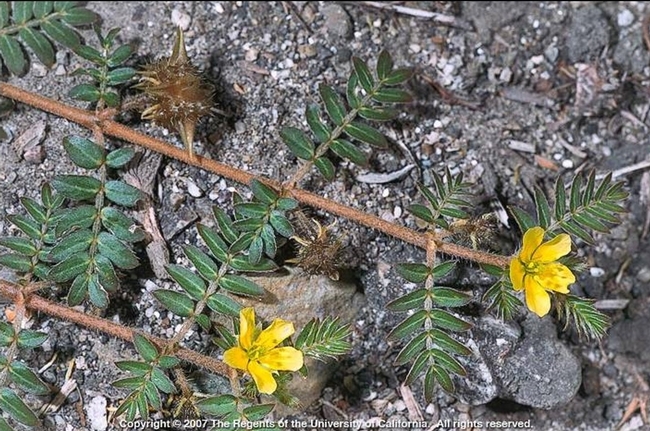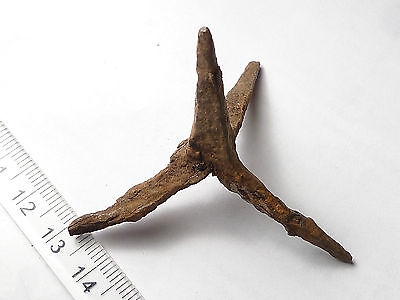
Posts Tagged: cover crop
Using Native Plants as Cover Crops
In late February, in an almond orchard in the Sacramento Valley, the fall-planted cover crop mix of grasses, brassicas and legumes had barely produced a green fuzz above the soil surface, and it was unclear when it would bloom.
Unfortunately, this scene is becoming more frequent across California, as climate change causes more prolonged droughts and rain-dependent winter cover crops can barely grow, which delays or reduces bloom, essential for supporting pollinators.
Fortunately, California native plant species have evolved with drought and have developed many strategies to survive and reproduce in those conditions.
Would it be possible to capitalize on the over 9 million acres of cropland in California for drought resilience and habitat restoration by utilizing more native species as cover crops? Our team at the UC Sustainable Agriculture Research and Education Program (UC SAREP) spent some time considering various native plant species and their potential ecological and operational attributes as cover crops. For a full list of species and their attributes, see https://ucanr.edu/sites/covercrops/.
Many native species are so well adapted to drought that they will still germinate and bloom during extremely dry years, for example, annuals like Tidy Tips (Layia platyglossa) and California poppy (Eschscholzia californica). Alternatively, perennial bulb species like Prettyface (Triteleia ixioides) and Bluedicks (Dipteronstemon capitatus) become dormant during the dry summer, retaining their bulbs below ground and re-growing when the rains return.
ADVERTISING
These species could perhaps fit well in no-till orchard systems. Summer dormancy is important for tree nut growers because they usually need clean ground under the trees during harvest. Moreover, the costs to terminate and reseed would potentially be eliminated. While these species are well-known by Native Americans for their edible bulbs, at this point in time, we are not aware of any cover cropping trials having ever been conducted with these species.
A harvestable product
Cover crops are not usually considered marketable crops. However, we should not preclude the potential for some plants that are useful as cover crops to provide a harvestable product as well.
Native perennial fiber plants such as Indian hemp dogbane (Apocynum cannabinum), narrow leaf milkweed (Asclepsias fascicularis), and common nettle (Urtica dioica) could offer the opportunity to cultivate summer cover crops that have a market value, especially in cases where farmers are already willing to irrigate their cover crops to improve their development and amplify the benefits.
Bowles Farming in the San Joaquin Valley is experimenting with growing these three species for fiber production. All three also attract native bees and important butterfly species such as monarchs (as long as farmers avoid spraying insecticides).
While we believe that some native species could open new opportunities for farmers as cover crops, we still have insufficient studies testing the effects and viability of these species.
Organizations like the NRCS Plant Materials Center at Lockeford and the Xerces Society are conducting practical studies with native species, creating plant guides and working with farmers to expand their use. In addition, researchers Lauren Hale of the USDA Agricultural Research Service and Anil Shrestha of California State University, Fresno, are using a 2021 UC SAREP small grant to study the effects of native species mixes on water demand and weed populations in San Joaquin Valley grape vineyards.
Hale suggests that below-ground ecosystems may benefit as much from native plants as above-ground ecosystems. Says Hale, “Because plants and their microbiomes have evolved together for millennia, it seems logical that native plants would promote a good response from the native soil microbiota.”
For additional information:
UC SAREP List of California Native Species for Potential Use as Cover Crops: https://ucanr.edu/sites/covercrops/
Xerces Society lists of pollinator-friendly native species for California: https://xerces.org/pollinator-resource-center/california
NRCS California Plant Materials Center plant guides: https://www.nrcs.usda.gov/wps/portal/nrcs/publications/plantmaterials/pmc/west/capmc/pub/
UC SAREP Cover Crops Database: https://sarep.ucdavis.edu/covercrop

cover crop citrus
Cover Cropping the Coast
Save the Date!
October 31, 9am – 11am
Hansen Agricultural Research and Extension Center
287 S Briggs Rd, Santa Paula
Come gather around a cover crop demonstration for a discussion on cover crop seed selections, appropriate mixes for different cropping systems, and management issues. Other soil health topics include compost applications, Healthy Soils grant opportunities, and technical assistance availability.
This event is free and open to anyone interested in soil health. Please spread the word!
More information to follow, if you can join us please RSVP here:
https://ucanr.edu/survey/survey.cfm?surveynumber=28259

citrus weeds and disc
Spotlight on Healthy Soils: Quaker Oaks Farm
Thanks to special guest author Shulamit Shroder for a glance at a Healthy Soils Program grant in action. Shulamit is Kern County's UCCE climate smart agriculture specialist.
Quaker Oaks Farm is a small nonprofit farm in Tulare County, near Visalia. About half of its 21 acres are devoted to restoring and maintaining a native wetland and riparian oak forest area. The rest is a diverse organic farming operation, with areas devoted to annual vegetable crops, grazed grasslands, and a small orchard.
As farm manager, Steven Lee applied for and received a Healthy Soils grant in 2017 to plant cover crops and hedgerows, apply compost and mulch, and establish a silvopasture area.
He believes that this investment in the farm's soil will pay off in the long term, so that the next generation can continue to enjoy the services provided by the nonprofit's complex landscape.
Between March 2018 and March 2021, the farm plans to:
- Plant cover crops on 4.5 acres
- Plant hedgerows on 0.3 acres
- Establish a 2.5 acre silvopasture area
- Apply mulch to 2 acres
- Apply compost to 6 acres
Benefits
Water usage: Dr. Lee reported that the mulch has helped keep young plants from wilting in the hot sun and that their overall water usage has decreased.
Energy usage: They have reduced their tillage operations, which has decreased their energy use and their carbon footprint.
Pests: Dr. Lee has witnessed an increase in beneficial insects since the start of the project, especially ladybugs. In 2018, the ladybugs did not migrate away from the farm during the hottest part of the summer like they had in previous years. The farm also did not have to spray organic pesticides in 2018, unlike in 2017. In addition, the increase in native pollinators should help to pollinate the fruit tree orchard, since the farm does not have its own beehive.
Disadvantages
Labor: Implementing these practices takes time, and Dr. Lee does most of the on-farm labor himself. He ended up prioritizing the Healthy Soils project over production during the past year, since the grant has offset his labor costs.
Learning curve: Determining optimal timing has been the steepest learning curve so far, such as figuring out when to plant the native hedgerow plants and when to replace the ones that died.
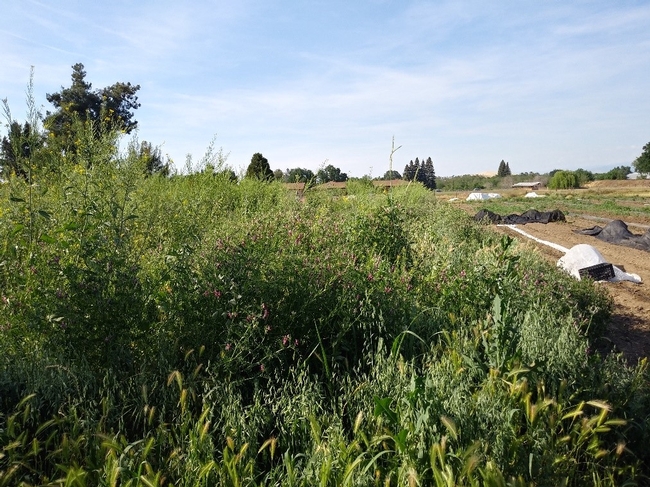
Climate smart agriculture encompasses management practices that increase soil carbon sequestration, reduce greenhouse gas emissions, improve yields and efficiencies, and promotes climate resilience. The California Department of Food and Agriculture (CDFA) supports three funding opportunities in climate smart agriculture: the Healthy Soils Program, the State Water Efficiency & Enhancement Program, and the Alternative Manure Management Program.
In a collaborative partnership, CDFA and UC Agriculture and Natural Resources have teamed up to support 10 community education specialists throughout the state to provide technical assistance and outreach for the climate smart agriculture programs. As one of these technical assistance providers, my role is to promote and support the adoption of these programs in Ventura County. If you are interested in working with me, please contact me at amrowe@ucanr.edu.
Ventura Grown Cover Crops
Petty Ranch, a story of cover crops in Ventura County.
“All of the lemon trees were dying.” Sigh. Another distressing story about agriculture in the face of climate change, rising land values, difficult economies, and soil degradation. Or is it? Chris Sayer, owner of Petty Ranch, walks me through his 50-acre property of figs, lemons, and avocados. In addition to his trees, Chris has a whole other system growing. Cover crops.
I am personally a huge fan of cover crops or green manure. Planting cover crops keeps the soil covered, which reduces the loss of topsoil to wind and rain. Additionally, cover crops are an inexpensive way to build soil carbon and improve soil structure. Depending on the cover crop chosen, root systems help penetrate and break up plowpan layers created from tractor compaction, increase water infiltration, reduce runoff, and improve nutrient cycling for cash crops. Many cover crop systems include legumes, which have the amazing power of fixing atmospheric nitrogen. In an association with bacteria, legumes “fix” nitrogen from the atmosphere into a biologically available form in the soil that plants can use. In this way, cover crops with legumes mixed in can increase nitrogen levels in the soil, allowing farmers to reduce fertilizer inputs.
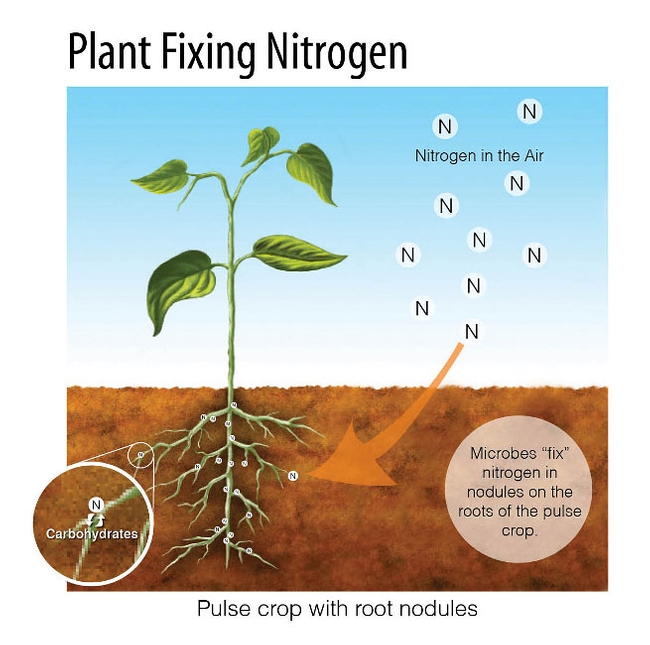
Back at the fig trees, Chris picks up a shovel. He easily scoops up a nice shovelful of soil, maneuvering the shovel into the earth with little effort. Chris explains to me that before they started cover cropping, this particular area was so compact couldn't get a shovel down even a few inches. Not even a plow could break ground below six inches. Daikon radishes and sugar beets helped improve soil structure in these heavy soils by breaking up compaction with their deep root structures. Triticale and barley add to the success by adding plentiful organic material and carbon to the soil.
Chris started cover cropping in 2005 in an attempt to build up his soil organic matter. His lemons were suffering on a heavy soil that had been compacted and degraded by years of production. When he got to the point where the trees were no longer productive, Chris decided to remove an area of lemon orchard and replace it with figs. After taking the lemons out, adding steer manure and gypsum to the soil, he planted cover crops for the first time.
Today, the entire 50-acre property has cover crops growing in between lemons, avocados, and figs. In Ventura County's climate, it makes sense to establish cover crop in the late fall when the first rains arrive, let them grow during the wet season, and terminate them when the rain disappears in the spring. On Petty Ranch, Chris lets some cover crop go to seed, saving him the money of repurchasing seed the following year. Once he terminates the cover, the plant matter decomposes and adds its organic material right back into the soil. Daikon radish, I learned while hanging out with Chris, acts like a sponge as it decomposes. Its structure holds water, improving overall soil moisture by allowing a slow release of water as the radish disappears.
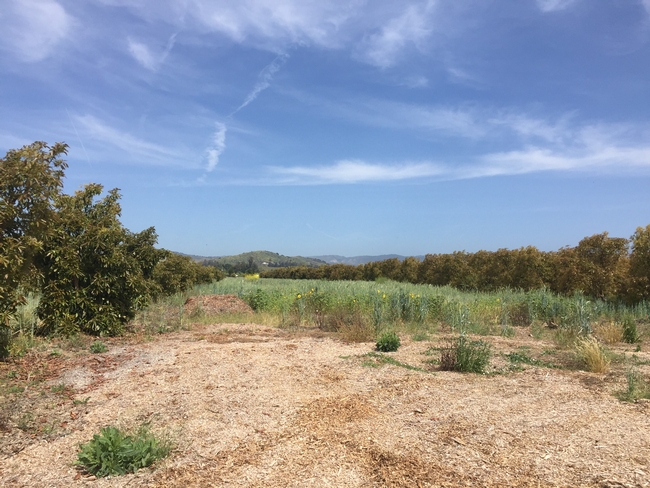
The extremely cool part about Chris's cover cropping is the noticeable change in organic matter and water flow on the ranch. Before he started cover cropping, Chris's soils measured about 2.5% organic matter, which is typical for Ventura County. Since he has been cover cropping, that number has increased to 5.5%. With the increase in organic matter, Chris has seen an increase in porosity, improved infiltration, and decreased runoff.
Cover crops are one strategy to build soil organic matter, increase water infiltration, and reduce greenhouse gas emission on agricultural lands. In addition, they have been shown to improve crop yields, increase biodiversity, attract beneficial pollinators, and act as weed suppressants. You can learn more about the benefits and types of cover crops through the Sustainable Agriculture Research & Education (SARE) learning center. The California Department of Food and Agriculture's Healthy Soils Program provides funding to farmers interested in practices such as cover cropping, alleviating some of the initial costs associated with starting the practice. For more information about cover crops or the Healthy Soils Program, please reach out to me or your closest UC Cooperative Extension community education specialist:
Mendocino County: Britta Baskerville – blbaskerville@ucanr.edu
Glenn County: Dana Brady – dmbrady@ucanr.edu
Yolo County: Emily Lovell – ejlovell@ucanr.edu
Santa Cruz County: Valerie Perez – valperez@ucanr.edu
Ventura County: Alli Rowe – amrowe@ucanr.edu
San Diego County: Esther Mosase – enmosase@ucanr.edu
Imperial County: Kristian Salgado – kmsalgado@ucanr.edu
Kern County: Shulamit Shroder – sashroder@ucanr.edu
Climate smart agriculture encompasses management practices that increase soil carbon sequestration, reduce greenhouse gas emissions, improve yields and efficiencies, and promotes climate resilience. The California Department of Food and Agriculture (CDFA) supports three funding opportunities in climate smart agriculture: the Healthy Soils Program, the State Water Efficiency & Enhancement Program, and the Alternative Manure Management Program.
In a collaborative partnership, CDFA and UC Agriculture and Natural Resources have teamed up to support 10 community education specialists throughout the state to provide technical assistance and outreach for the climate smart agriculture programs. As one of these technical assistance providers, my role is to promote and support the adoption of these programs in Ventura County. If you are interested in working with me, please contact me at amrowe@ucanr.edu
Goathead is Out to Puncture Your Tires
Puncturevine (Tribulus terrestris) kept a low profile during the drought years but seems to have exploded following this year's rains. (It is still ‘lying low', so to speak, but there is a lot more of it.)
Also known as goatheads or caltrop, puncturevine is a prostrate annual that produces large, hard, spiked seeds. The seeds disseminate by sticking to animals, tires, and feet, and can easily puncture bike and ATV tires. I tried to do a puncturevine study once but couldn't get the seeds to germinate; my theory now is that the seeds have to be run over by a vehicle before they'll sprout. Conveniently, the plant is commonly found along dirt roads, on roadsides, and on the edges of ag fields.
Puncturevine is native to southern Eurasia and Africa. It is in the plant family Zygophyllaceae, which also includes the creosote bush native to the Mojave Desert.
Extracts from puncturevine seed and other plant parts are available as a dietary supplement, and are reputed to boost virility. I'm guessing this is a holdover from the old medical idea of homology, where the shape of a plant suggested the ailment it was supposed to cure. And the puncturevine seed looks sort of like a goat head, and goats are, you know, lusty. However, WebMD says “Taking tribulus as a supplement for a short time is probably safe, provided that you're healthy and you are not pregnant or breastfeeding.” Hardly a ringing endorsement.
Two species of weevil from puncturevine's native range have been introduced into the U.S. They help keep puncturevine populations in check but they seem to be locked in a boom-and-bust cycle with the plant: when puncturevine populations crash, so do the weevils, and the plant resurges the following year.
More information on this species, including methods for control, are available in a Weed Report at the Weed Research and Information Center and in UC-ANR's Pest Notes.

puncturevine stem2


